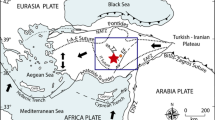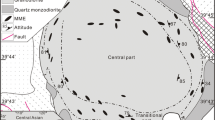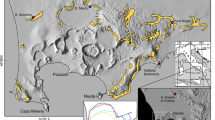Abstract
Thirty-six basalt samples from near East Pacific Rise 13°N are analyzed for major and trace elements. Different types of zoned plagioclase phenocrysts in basalts are also backscatter imaged, and major element profiles scanned and analyzed for microprobe. Basalts dredged from a restricted area have evolved to different extents (MgO=9.38wt%—6.76wt%). High MgO basalts are modeled for crystallization to MgO of about 7wt%, and resulted in the Ni contents (≈28 ppm) that are generally lower than that in observed basalts (>60 ppm). It suggests that low MgO basalts may have experienced more intensive magma mixing. High MgO (9.38wt%) basalt is modeled for self-“mixing-crystallization”, and the high Ni contents in low MgO basalts can be generated in small scale and periodical self-mixing of new magma (high MgO). “Mixing-crystallization” processes that low MgO magmas experienced accord with recent 226Ra/230Th disequilibria studies for magma residence time, in which low MgO magmas have experienced more circles of “mixing-crystallization” in relatively longer residence time. Magma mixing is not homogeneous in magma chamber, however, low MgO magmas are closer to stable composition produced by periodical “mixing-crystallization”, which is also an important reason for magma diversity in East Pacific Rise. Zoned plagioclase phenocrysts can be divided into two types: with and without high An# cores, both of which have multiple reversed An# zones, suggesting periodical mixing of their host magmas. Cores of zoned plagioclase in low MgO (7.45wt%) basalt differ significantly with their mantle in An#, but are similar in An# with microlite cores (products of equilibrium crystallization) in high MgO (9.38wt%) basalt, which further shows that plagioclase phenocryst cores in low MgO basalts may have formed in their parental magmas before entering into the magma chamber.
Similar content being viewed by others
References
Sinton J M, Detrick R S. Mid-ocean ridge magma chambers. J Geophys Res, 1992, 97: 197–216
MacLeod C J, Yaouancq G. A fossil melt lens in the Oman ophiolite: Implications for magma chamber processes at fast spreading ridges. Earth Planet Sci Lett, 2000, 176: 357–373
Couch S, Sparks R S J, Carroll M R. Mineral disequilibrium in lavas explained by convective self-mixing in open magma chambers. Nature, 2001, 411: 1037–1039
O’Hara M J. Geochemical evolution during fractional crystallization of a periodically refilled magma chamber. Nature, 1977, 266: 503–507
Blake S. Volcanism and the dynamics of open magma chambers. Nature, 1981, 289: 783–785
Langmuir C H. Geochemical consequences of in situ crystallization. Nature, 1989, 340: 199–205
Ribe N M. On the dynamics of mid-ocean ridges. J Geophys Res, 1988, 93: 429–436
Spiegelman M, Reynolds J R. Combined dynamic and geochemical evidence for convergent melt flow beneath the East Pacific Rise. Nature, 1999, 282: 282–285
Oldenburg C M, Spera F J. Dynamic mixing in magma bodies: Theory, simulation, and implications. J Geophys Res, 1989, 94: 9215–9236
Huppert H E, Sparks R S J, Whitehead J A. Replenishment of magma by light imputs. J Geophys Res, 1986, 91: 6113–6122
Martin D, Nokes R. Crystal settling in a vigorously convecting magma chamber. Nature, 1988, 332: 534–536
Smewing J D. Mixing characteristics and compositional differences in mantle-derived melts beneath spreading axes: Evidence from cylically layered rocks in the ophiolite of north Oman. J Geophys Res, 1981, 86: 2645–2659
MacLeod C J, Yaouancq G. A fossil melt lens in the Oman ophiolite: Implications for magma chamber processes at fast spreading ridges. Earth Planet Sci Lett, 2000, 176: 357–373
Blake S, Rogers N. Magma differentiation rates from (226Ra/ 230Th) and the size and power output of magma chambers. Earth Planet Sci Lett, 2005, 236: 654–669
Perugini D, Poli G, Valentini L. Strange attractors in plagioclase oscillatory zoning: Petrological implications. Contrib Mineral Petrol, 2005, 149: 482–497
Landi P, Metrich N, Bertagnini A, et al. Dynamics of magma mixing and degassing recorded in plagioclase at Stromboli (Aeolian Archipelago, Italy). Contrib Mineralogy Petrol, 2004, 147: 213–227
Vigiera N, Bourdona B, Joronb J L, et al. U-decay series and trace element systematics in the 1978 eruption of Ardoukoba, Asal rift: Timescale of magma crystallization. Earth Planet Sci Lett, 1999, 174: 81–98
Sims K W W, Goldstein S J, Blichert-Toft J, et al. Chemical and isotopic constraints on the generation and transport of magma beneath the East Pacific Rise. Geochim Cosmochim Acta, 2002, 66: 3481–3504
Dungan M A, Rhodes J M. Residual glasses and melt inclusions in basalts from DSDP Legs 45 and 46: Evidence for magma mixing. Contrib Mineral Petrol, 1978, 67: 417–431
Shibata T, DeLong S E, Walker D. Abyssal tholeiites from the Oceanographer fracture zone: I. Petrology and fractionation. Contribu Mineral Petrol, 1979, 70: 89–102
Kelemen P B, Koga K, Shimizu K K. Geochemistry of gabbro sills in the crust-mantle transition zone of the Oman ophiolite: Implications for the origin of the oceanic lower crust. Earth Planet Sci Lett, 1997, 146: 475–488
Korenaga J, Kelemen P B. Origin of gabbro sills in the Moho transition zone of the Oman ophiolite: Implications for magma transport in the oceanic lower crust. J Geophys Res, 1997, 102: 27729–27749
MacLeod C J, Yaouancq G. A fossil melt lens in the Oman ophiolite: Implications for magma chamber processes at fast spreading ridges. Earth Planet Sci Lett, 2000, 176: 357–373
Boudier F, Nicolas A, Ildefonse B. Magma chambers in the Oman ophiolite: fed from the top and the bottom. Earth Planet Sci Lett, 1996, 144: 239–250
Caroff M, Fleutelot C. The north-south propagating spreading center of the North Fiji Basin. Modeling of the geochemical evolution in periodically replenished and tapped magma chambers. Mineral Petrol, 2003, 79: 203–224
Almeev R R, Holtz F, Koepke J, et al. The effect of H2O on olivine crystallization in MORB: Experimental calibration at 200 MPa. Am Mineral, 2007, 92(4): 670–674
Choukroune P, Francheteau J, Hekinian R. Tectonics of the East Pacific Rise near 12°50′N: A submersible study. Earth Planet Sci Lett, 1984, 68: 115–127
Zeng Z G, Wang X Y, Zhang G L, et al. Formation of Fe-oxyhydroxides from the East Pacific Rise near latitude 13°N: Evidence from mineralogical and geochemical data. Sci China Ser D-Earth Sci, 2008, 51(2): 206–215
Ballard R D, Hekinian R, Francheteau J. Geological setting of hydrothermal activity at 12°50′N on the East Pacific Rise: A submersible study. Earth Planet Sci Lett, 1984, 69: 176–186
Niu Y L, Batiza R. An empirical method for calculating melt compositions produced beneath mid-ocean ridges: Application for axis and off-axis (seamounts) melting. J Geophys Res, 1991, 96: 21753–21777
Hirose K, Kushiro I. Partial melting of dry peridotites at high pressures: Determination of compositions of melts segregated from periodotite using aggregates of diamond. Earth Planet Sci Lett, 1993, 114: 477–489
Salters V J M. The generation of mid-ocean ridge basalts from the Hf and Nd isotope perspective. Earth Planet Sci Lett, 1993, 141: 109–123
Hekiniana R, Francheteaub J, Armijoc R, et al. Petrology of the Easter microplate region in the South Pacific. J Volcanol Geotherm Res, 1996, 72: 259–289
Niu Y L, Waggoner D G, Sinton J M, et al. Mantle source heterogeneity and melting processes beneath seafloor spreading centres: The East Pacific Rise, 18°–19°S. J Geophys Res, 1996, 101: 27711–27733
Taylor B, Martinez F. Back-arc basin basalt systematics. Earth Planet Sci Lett, 2003, 210: 481–497
Macdougall J D, Lugmair G W. Sr and Nd isotopes in basalts from the East Pacific Rise: Significance for mantle heterogeneity. Earth Planet Sci Lett, 1986, 77: 273–284
Niu Y L, Regelous M, Wendt I J, et al. Geochemistry of near-EPR seamounts: Importance of source vs. process and the origin of enriched mantle component. Earth Planet Sci Lett, 2002, 199: 327–345
Castillo P R, Klein E, Bender J, et al. Petrology and Sr, Nd, and Pb isotope geochemistry of mid-ocean ridge basalt glasses from the 11°45′N to 15°00′N segment of the East Pacific Rise. Geochem Geophys Geosys, 2000, doi: 10.1029/1999GC000024
Chaussidon M, Sheppard S M F, Hydrogen M A. Hydrogen, sulphur and neodymium isotope variations in the mantle beneath the EPR at 12°50′N. J Geochem Soc, 1991, 3: 325–337
Hamelin B, Dupper B, Allegre C J. Lead-Strontium isotopic variations along the East Pacific Rise and the mid-Atlantic ridge: A comparative study. Earth Planet Sci Lett, 1984, 67: 340–350
Caroff M, Fleutelot C. The north-south propagating spreading center of the North Fiji Basin. Modeling of the geochemical evolution in periodically replenished and tapped magma chambers. Mineral Petrol, 2003, 79: 203–224
Boynton W V. Cosmochemistry of the rare earth elements: meteorite studies. In: Rare Earth Element Geochemistry. Amsterdam: Elsevier Press, 1984. 63–114
Grove T L, Baker M B, Kinzler R J. Coupled CaAl-NaSi diffusion in plagioclase feldspar: Experiments and applications to cooling rate speedometry. Geochim Cosmochim Acta, 1984, 48: 2113–2120
Takagi D, Sato H, Nakagawa M. Experimental study of a low-alkali tholeiite at 1–5 kbar: Optimal condition for the crystallization of high-An plagioclase in hydrous arc tholeiite. Contrib Mineral Petrol, 2005, 149: 527–540
Ginibre C, Worner G, Kronz A. Minor-and trace-element zoning in plagioclase: Implications for magma chamber processes at Parinacota volcano, northern Chile. Contrib Mineral Petrol, 2002, 143: 300–315
Blundy J D, Shimizu N. Trace element evidence for plagioclase re cycling in calc-alkaline magmas. Earth Planet Sci Lett, 1991, 102: 178–197
Danyushevsky L V. The effect of small amounts of H2O on crystallisation of mid-ocean ridge and backarc basin magmas. J Volcanol Geotherm Res, 2001, 110: 265–280
Berlo K, Blundy J, Turner S, et al. Textural and chemical variation in plagioclase phenocrysts from the 1980 eruptions of Mount St. Helens, USA. Contrib Mineral Petrol, 2007, 154: 291–308
le Roux P J, le Roex A P, Schilling J G. Crystallization processes beneath the southern Mid-Atlantic Ridge (40–55°S), evidence for high-pressure initiation of crystallization. Contrib Mineral Petrol, 2002, 142: 582–602
Li C, Ripley E M, Mathez E A. The effect of S on the partitioning of Ni between olivine and silicate melt in MORB. Chem Geol, 2003, 201: 295–306
Defant M J, Nielsen R L. Interpretation of open system petrogenetic processes: Phase equilibria constraints on magma evolution. Geochim Cosmochim Acta, 1990, 54: 87–102
Huppert H E, Sparks R S J. Restrictions on the compositions of mid-ocean ridge basalts: A fluid dynamical investigation. Nature, 1980, 286: 46–48
Niu Y L, Batiza R. In situ densities of MORB melts and residual mantle: Implications for buoyancy forces beneath mid-ocean ridges. J Geol, 1991, 99: 767–775
Turner J S. A fluid-dynamical model of differentiation and layering in magma chambers. Nature, 1980, 285: 213–215
Detrick R S, Buhl P, Vera E, et al. Multi-channel seismic imaging of a crust magma chamber along the East Pacific Rise. Nature, 1987, 326: 35–41
Harding A J, Orcutt J A, Kappus M E, et al. Structure of young oceanic crust at 13°N on the East Pacific Rise from expanding spread profiles. J Geophys Res, 1989, 94: 12163–12196
Author information
Authors and Affiliations
Corresponding author
Additional information
Supported in part by the Pilot Project of Knowledge Innovation Project, Chinese Academy of Sciences (Grant Nos. KZCX3-SW-223 and KZCX2-YW-211), and the Special Foundation for the Eleventh Five Plan of China Ocean Mineral Resources R & D Association (Grant No. DYXM-115-02-1-03)
Rights and permissions
About this article
Cite this article
Zhang, G., Zeng, Z., Yin, X. et al. Periodical mixing of MORB magmas near East Pacific Rise 13°N: evidence from modeling and zoned plagioclase phenocrysts. Sci. China Ser. D-Earth Sci. 51, 1786–1801 (2008). https://doi.org/10.1007/s11430-008-0139-8
Received:
Accepted:
Published:
Issue Date:
DOI: https://doi.org/10.1007/s11430-008-0139-8




